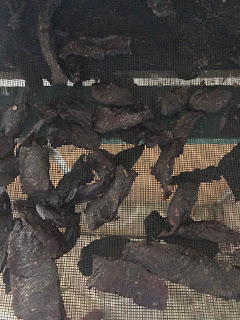Marinating the meat
drying the meat in my dehydrator
Jerky
I mentioned my dried veggie seasoning in my last post. This is great to do when you have excess veg. I like to use whatever veg I have growing, or am not likely to use up, and will usually add some herbs from the garden as well. I've used kale, new guinea bean, snake beans, chilli, garlic, pumpkin, mooring, capsicum, celery, zucchini. Basically you want a nice tasty dried veggie stock powder that you can use to season meals or even just to make a simple cup of soup with either hot water or bone broth. I do this in the dehydrator, and yes, I know I should be sun drying, but I just haven't gotten around to that, and I do wonder how it would go as it's always so dusty around here. Sun drying would be the most environmental way of preserving foods.
Veggie stock powder
When we stayed in Daylseford, the Permie Love Shack had a lovely bouquet in a vase - a bouquet of Bay leaves. Meg said that I was welcome to take them if I wanted to, so I did. I put them in a bag and hung them until dry. I did the same in Canberra when I bought curry leaves (they come in a lot bigger portion than we needed). I hung them in a paper bag until dry. Herbs are much easier to dry in bags and hang up than any other way. I like them in a bag as you don't lose any bits that would otherwise end up on the floor and the bag also keeps the dust out. Rosemary is one herb that I struggle to grow here, so whenever I get an opportunity to
I love to dry mushrooms when we get a bountiful wild crop. We only eat the common field mushroom and I must caution you, to make sure you know what you're doing when eating wild mushrooms. I know what we can eat and that's all I do eat. I got excited when we were away because I thought I'd found pine mushrooms, but after checking with a wild food facebook group they said not to eat them. I like to keep it safe. We walk around the paddocks having competitions to see who picks the most. Our mushrooms are usually very dirty so I get them home, brush them off and even wash some if they are really bad. I then place them gill side down on the dryer trays and because they aren't really fleshy like the bought ones, they dry pretty quickly. I do make sure they are VERY dry as I don't like moldy mushies! Then they are processed to a powder. Even after drying, there is often a bit of grit still in the mushrooms, but not nearly as much as when you cook them fresh.
Dried tomatoes are another favourite. I like to use the small ones for drying - just cut in half and if I think of it, I sprinkle with salt first. I fully dry them, rather than semi dried because that's how I like them. Also, you can keep jars full of dried tomatoes in the cupboard and then just marinate them as you want, which saves fridge space and they last longer.
My method for marinating is this:
Place the dried tomatoes in a bowl, then cover with a mix of half hot water and half vinegar. Allow to soak until cool. Drain off the liquid and add chopped herbs and garlic. Toss around and then place into a jar with olive oil. A trick I've discovered is to add a little sunflower oil with the olive oil and this prevents it from going cloudy in the fridge - you only need a tablespoon or two of sunflower oil. I know that sunflower oil is a seed oil but at least it's not genetically modified and I also think it's okay because it was a traditional oil (of the American Indians).
When you grow New Guinea Beans, Snake Beans or Zucchini, you will often have an abundance! These veg are best preserved by drying. Dried and packed into jars they will keep for a very long time in the pantry. The last lot of New Guinea Beans we did, we sprinkled salt on them and they were a nice little beer snack.
A little while ago I made Gomasio with foraged seaweed - I need another trip to the beach as I've eaten all this one. I posted about it here.
I did hang this to dry and it only took a couple of days.
Mango is a delicious dried snack. Yes, I know, mango is delicious no matter what you do with it! We have one common mango tree, which is otherwise called a cooking mango - great for chutney but once dried, you can't tell the difference between a dry common mango and a dry bowen mango. I'll dry banana's too when I have a home grown bunch. You get a massive bunch and they all ripen at once, so freezing or drying is what I do. Mostly frozen as it's great for making nice cream. Most fruits can be dried - just slice about 1/2 cm thick and usually takes between 12 and 24 hours to dry.
I like drying as a storage/preservation method for a few reasons:
- drying reduces the volume so takes less room in storage
- dried foods keep in glass jars at room temperature
- not needing to freeze leaves more room for other things to go into the freezer
- if sun-drying, it's very eco friendly.
What do you like to dry?







This comment has been removed by the author.
ReplyDelete